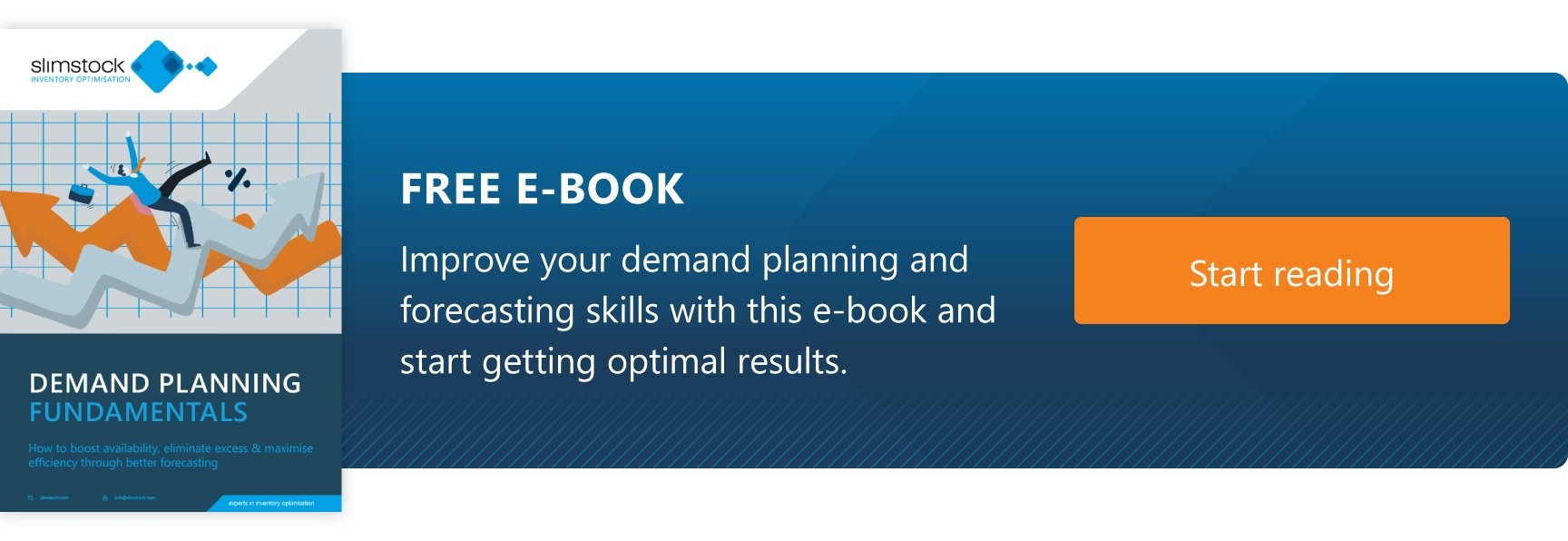How can you take advantage of Machine Learning to make better supply chain decisions?
For years, businesses have strived to implement intelligent technologies. The end goal is that these machines not only make decisions, but that these decisions are ‘good’ and do not need to be validated by a human.
As businesses embrace AI, Machine Learning and other advanced techniques, how can you utilise this revolutionary technology to create efficiency gains throughout the supply chain?
Throughout this article, we will delve into the crucial role that Machine Learning already plays in our day-to-day lives, as well as how businesses can exploit it to create competitive advantage.
From implementing Machine Learning for product demand forecasting, to enriching your supply planning process, we’ll explore some of the clever supply chain applications that are already delivering fantastic results.
Can machines make ‘good’ decisions?
We live in a world where technology is a fundamental part of our everyday lives, and the technologies we depend on are advancing at an exponential rate. Examples of clever Machine-Learning-enabled algorithms can be seen in all walks of life:
- The way we find products on the internet
- How we make bank transactions
- When we write a few words in an email and the machine proposes the end of the sentence
- And increasingly, how tools like ChatGPT create humanlike conversational dialogue
Many of these algorithms utilise each piece of data they accumulate to learn and improve. One famous example is IBM’s Deep Blue Chess (DBC) system. In 1997, the machine managed to defeat the World Chess Champion, Garry Kasparov, using algorithms that were perfected through Machine Learning.
However, these advances are not without consequence. It is almost as though our world could start to resemble a chapter of Black Mirror. Or rather, we have all become a person of interest who is constantly being watched. And yet, we are all convinced that these innovative technologies make our life easier, better and faster.
If we extrapolate this to the complexity of the supply chain, the application of this intelligent technology is something that has been going on for a long time. However, the focus has mainly been on the automation of processes in factories. The icing on the cake is in developing machines to learn how to solve problems by making the best decisions autonomously.
Let’s start with the basics
First, let’s explain some of the fundamental concepts.
No doubt, you have come across the concepts of Artificial Intelligence and Machine Learning, but for the purpose of bringing clarity to the equation, let’s define them:
What is Artificial Intelligence (AI)?
In essence, this is the concept of trying to get machines to match human behaviour. In recent times, this has gained importance due, in part, to the sheer volume and variety of data that companies are now able to collect and the speed at which they can process it.

What is Machine Learning?
This is a discipline within AI that is dedicated to the study of algorithms which are designed to perform a task using data. More importantly, the machine uses this data to automatically learn and improve without human intervention.
In essence, Machine Learning combines applied statistics and computer science with speed and precision to predict future behaviour. To do this, they need to collect and store a large amount of data (Big Data), which can often be a handicap for many businesses.
What is Data Science and Advanced Analytics?
Data science covers the exploration and interpretation of data to unlock meaningful insights for businesses. Combining principles and practices from the fields of mathematics, statistics, Artificial Intelligence and Machine Learning, this advanced analysis approach allows businesses to analyse vast amounts of data.
This in turn can be used to make a descriptive analysis (which is based on explaining what has happened through statistics, graphs and tables). However, where Machine Learning techniques really add value is by performing two more sophisticated types of analysis: predictive analytics (making predictions based on past situations for future use); and prescriptive analysis (simulating different scenarios and evaluating what actions will attain the best results in the future).
Machine Learning in action
As we have mentioned, the applications of Machine Learning are extensive. But let’s take a simple example to showcase how Machine Learning techniques can be utilised to attain better business outcomes.
Imagine that you work for a gym, and you want to try and retain customers who may be thinking about cancelling their membership during the following few weeks. Your goal is to identify those members and then engage them at the right moment to persuade them to stay.
Let’s see how this plays out:
How could Machine Learning bring value to your supply chain?
The integration of Machine Learning in supply chain management helps businesses to automate tasks of seemingly little value, allowing more time to focus on strategic and higher impact business activities. However, Machine Learning opens a universe of more ambitious possibilities.
Here are some examples of how Machine Learning has benefitted supply chain teams:
Supply chain management
- Optimising the routes of replenishment deliveries throughout different points of the logistics network in real-time
- Creating a supplier order calendar considering multiple constraints such as storage costs, delivery lead time, warehouse capacity, etc
- Providing an understanding in real-time exactly where every pallet sits within the supply chain and the means of determining the precise arrival time at the next point in the chain
Warehouse optimisation
- Automating quality inspections using image recognition to detect damage to containers and packaging
- Designing the layout of products within the warehouse, optimising preparation routes, minimising errors in preparation, etc
- Improving resource management by considering information on expected absenteeism and staff turnover in order to optimise shift patterns
- Determining the best time to perform preventive maintenance of machinery and equipment to reduce downtime
Production Planning
- Collecting data to understand the productivity of machines and identifying opportunities to optimise (for example, redistributing production times)
- Automating repetitive actions to increase production speed and agility, allowing staff to focus on other types of tasks that add more value
- Enabling personalisation and customisation, with maximum precision and rapid production
- Detecting possible production anomalies, ensuring that they don’t impact the production process
How can you utilise Machine Learning for product demand forecasting?
So far, we have been talking about the applications of Machine Learning in the supply chain in a general sense. In the next section, we will focus on a more specific area, where the power of this exciting technology is delivering real results.
By enabling businesses to create increasingly more accurate forecasts, Machine Learning is playing a significant role in helping businesses enhance decision-making processes. When applied to product demand forecasting, the strengths of Machine Learning are clear.
When you consider the nature of this critical supply chain process, Machine Learning is a natural fit for product demand forecasting:
- Forecasting techniques typically rely on an extensive pool of data
- With multiple data sources and layers of aggregation, there is often a high degree of complexity
- The resulting insights can be used to support decision making across the organisation and can even extend to selecting supply chain partners
Given the complexity and criticality of product demand forecasting to support an effective supply chain decision making process, many businesses adopt statistical models to anticipate future demand. However, bringing Machine Learning into the mix allows businesses to create visibility that simple statistical models alone cannot match.
Let’s delve into this further and explore 3 practical applications of Machine Learning in product demand forecasting:
1) Forecasting demand for new products
New products are notoriously difficult to plan for. However, by applying Machine Learning algorithms with advanced configuration, Machine-Learning-enabled systems can autonomously cluster demand history from multiple products to identify and anticipate trends in demand. This, in turn, enables the system to predict the potential future volume of demand.
The result: supply chain teams can build robust forecasts for new products far quicker, while simultaneously removing uncertainty and risk from new product launches.
2) Forecasting anomaly detection
Using similar techniques to those relied upon in fraud detection, Machine Learning techniques enable supply chain teams to identify outliers in demand history and exclude this from any analysis. Furthermore, by utilising advanced neural networks to cluster SKUs that are highly sensitive to anomalies, these products can be managed more proactively.
By detecting anomalies in customer transactions, availability and inventory status, the robustness of other supporting algorithms only improves.
3) Optimising promotions
There is no question that promotions present businesses with some major headaches. However, as Machine Learning algorithms advance, businesses are harnessing the technology to optimise the decision-making process around promotions.
By utilising a technique called ‘deep reinforcement learning’, businesses can develop more effective promotions policies that boost sales and minimise risk of unplanned markdown.

Pre-requisites for applying Machine Learning principles to your operation
Given the increasing number of potential data sources, coupled with the rapid rate of evolution in computing power, Machine Learning can be a tremendously powerful tool in both product demand forecasting and other key supply chain processes.
Yet, in essence it is still “just another tool in the box”. And of course, there are downsides to Machine Learning. Therefore, it should not become a goal for companies to ‘do’ Machine Learning for the sake of it.
Machine Learning is not The Holy Grail; it finds its strength in situations where data is abundant, but the degree of complexity is so high that traditional mathematics falls short. But exactly how much data are we talking about?
If we have a situation with 5 variables that can each take on 10 different values, then we already have thousands of possible combinations for the machine to learn. In forecasting, for example, there are often many more variables that can take on multiple values.
If the data is available, Machine Learning has enormous power. However, in practice, this is the greatest weakness of Machine Learning. Managers must therefore consider how data can be collected in a structured, efficient and ‘clean’ way.
Machine Learning also requires a lot of computing power. Some Machine Learning algorithms are based upon an enormous number of numerical computations, and this can sometimes be a problem in inventory management.
In addition, it is important to keep in mind the fact that solutions in inventory management do not only rely on quantitative results. Ultimately, it is the people who must understand, and work with, the solutions.
Management must therefore monitor this closely. As a result, it is important to facilitate knowledge about Machine Learning and theoretical inventory management across the company.
Even so, for companies that hope to work more efficiently, Machine Learning offers significant competitive advantages. From beating World Chess Champions, to helping you attain more dependable insights into future demand, Machine Learning presents businesses with new opportunities that are already revolutionising today’s supply chain.








